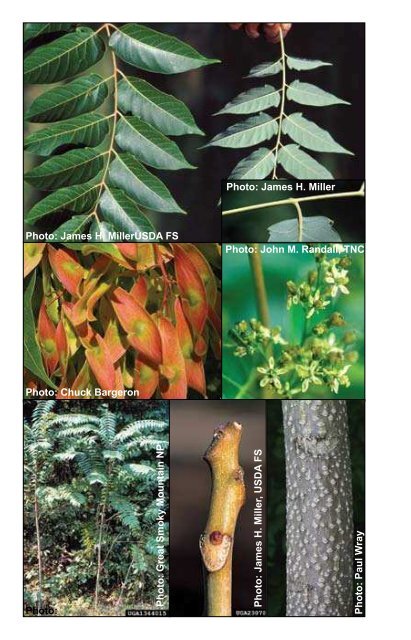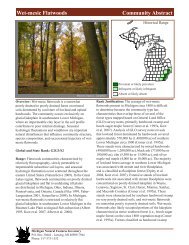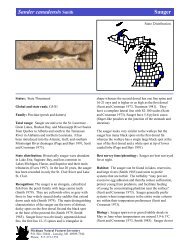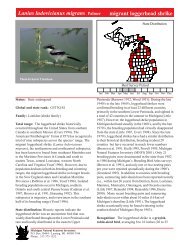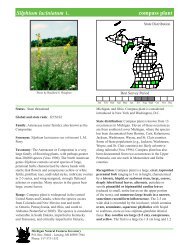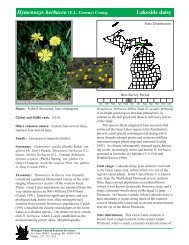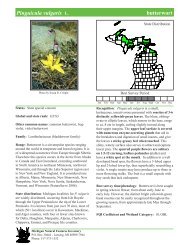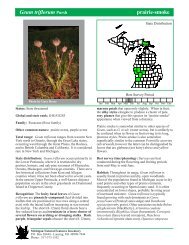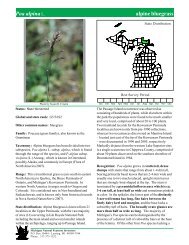Invasive Plants - Michigan Natural Features Inventory - Michigan ...
Invasive Plants - Michigan Natural Features Inventory - Michigan ...
Invasive Plants - Michigan Natural Features Inventory - Michigan ...
Create successful ePaper yourself
Turn your PDF publications into a flip-book with our unique Google optimized e-Paper software.
Photo: James H. MillerUSDA FS<br />
Photo: Chuck Bargeron<br />
Photo: Great Smoky Mountain NP<br />
Photo: James H. Miller<br />
Photo: John M. Randall, TNC<br />
Photo: James H. Miller, USDA FS<br />
Photo: Paul Wray<br />
Tree of Heaven<br />
Ailanthus altissima<br />
Habit: Deciduous small to large tree; 12-20 m (40-65 ft) tall and<br />
60-100 cm (24-40 in) in diameter; crown wide-spread with<br />
multiple branches.<br />
Leaves: Alternate; pinnately compound with 11-30 lance-shaped<br />
leaflets; leaves 30-90 cm (1-3 ft) long; 1-5 small gland tipped teeth<br />
near the base of each leaflet; dark green above, pale green below,<br />
turn yellow in fall; smell like rancid peanut butter when crushed.<br />
Stems/bark: Twigs very stout, light to dark brown, smooth with<br />
large V-shaped leaf scars; bark thin, gray to brownish gray, smooth<br />
with shallow cracks appearing on older trunks.<br />
Flowers: Small, yellow-green, five-petaled; borne in dense clusters<br />
near ends of upper branches; bloom in late spring; male and female<br />
flowers on different plants; pollen has an offensive odor.<br />
Fruits/seeds: Two-winged, papery, flat samara; reddish when ripe;<br />
develop in clusters on female trees in fall; persist in winter; germinate<br />
readily; dispersed by wind, birds and water.<br />
Habitat: Shade intolerant; thrives in poor soils; found in disturbed<br />
soils, fence rows, fields, roadsides, woodland edges, forest openings<br />
and rocky areas.<br />
Reproduction: By seed and vegetatively via root suckering; up to<br />
350,000 seeds produced annually by a single plant.<br />
Similar species: Crushed leaves or broken stems of native sumacs<br />
(Rhus spp.), walnuts (Juglans spp.) and ash (Fraxinus spp.) lack<br />
rancid peanut butter aroma and gland-tipped teeth at base of leaves.<br />
Comments: Native to Asia. Extensive cloning; allelopathic properties<br />
present; very fast growing.<br />
Monitoring & rapid response: Monitor roadsides and woodland<br />
edges, paths; hand pull seedlings before taproot develops<br />
(< 3 months) as taproot fragments may resprout. Resprouts following<br />
cutting, girdling, mowing, and burning—follow-up treatment<br />
required; girdling followed by herbicide most effective; treat cut<br />
stumps with herbicide—all stems in a clone must be treated; basal<br />
bark treatment with herbicide provides good root kill, particularly<br />
in fall; foliar herbicide treatment is effective on small trees.<br />
10 Photo:<br />
11


